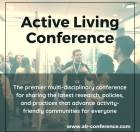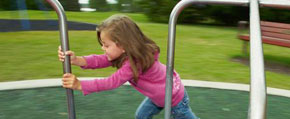We are pleased to announce an exciting new alliance between Active Living Research and GP RED to co-host and coordinate...
Programming, Community Involvement, and Park Safety: What Matters in Getting People More Active?
Presentation at the 2009 Active Living Research Annual Conference
Background:
Parks typically have no benchmarks to determine how many people are using their parks and how active they are. Decisions on programming are determined in part by administrative directives with local input through Park Advisory Boards (PABs). Perceptions of safety, programming, outreach and events may be important in park use, but how much each contributes is not known.
Objectives:
To determine whether parks programs, community involvement and other factors are associated with more park use.
Methods:
We surveyed parks to determine the programs offered, the number of program participants, the extent of community involvement in parks advisory boards, the frequency of meetings, and the number of members. We also counted people in the park over 1 week using SOPARC.
Additionally, we conducted surveys of both park users and households within a one-mile radius of each park. We gathered neighborhoods information on population density and demographic and socioeconomic status in a 1 mile radius around each park. We determined which factors were most predictive of greater levels of physical activity and park users.
Results:
From the Park Directors questionnaire based on 24 parks, a total of 249 programs were offered over a 12 month period and served 26,943 participants. The average number of programs offered was 10 (std dev 2.4). These programs were primarily attended by children and teenagers, 17,307 and 5,519 respectively; fewer programs were attended by adults and seniors, 3,261 and 862 respectively. Park Advisory Boards are established at 17 of the 24 parks. On average, the PABs have 8 members (std dev 4.9) and met 4 times per 12 month period (std dev 2.0).
Survey and observation results are currently available on 8 parks, but will be available on more than 24 for the presentation. We surveyed 601 park users and 411 area residents. Approximately 79% of the park users visit the park frequently (at least once a week) compared to only 21% of the area residents. Park users were slightly more likely to have participated in a park sponsored program within the previous 12 months than residents (7.35% to 4.65%, p = 0.082). Only 2.8% of respondents had ever participated in efforts to influence the programs offered at their neighborhood park.
We did not see any statistically significant relationships between community involvement in the park advisory board (PAB), park use, park programs offered and reported program participants. In this sample of 8 parks, there were an average of nearly 2200 users observed in parks without a regular PAB meeting and less than 1500 counted in parks with a PAB that met 4 or more times per year. Neighborhoods with higher rates of household poverty were less likely to have parks with an active PAB. However, where parks did not have active PABs 25% of residents reported visiting the parks at least once a week vs. 15% in parks with an active PAB. More park users were observed in neighborhoods with a higher number of households in poverty.
There was a trend in which more park users were observed in parks that offered more programs (p< .10) with an average of nearly 2400 observed in parks that offered an average of 12 programs vs. < 1,500 observed in parks that offered an average of 10 programs. Fewer programs were offered in neighborhoods with higher percentage minority population. There were no differences in perceived safety of parks, regardless of an active PAB, or how many people were observed in the park. Perceived park safety was higher in parks that offered fewer programs.
Conclusions:
Many of our findings are contrary to what might be assumed as the conventional wisdom. We did not find significant associations between park use and community involvement in parks and perceptions of park safety. We will report results based upon observations in all 24 parks to see if these findings are robust with a larger sample size.
Support:
This project was supported by NHLBI # R01HL083869
STAY UP TO DATE
RECENTLY ADDED TOOLS & RESOURCES
MOVE! A BLOG ABOUT ACTIVE LIVING
The "Active Living Conference" aims to break down research and practice silos and...







